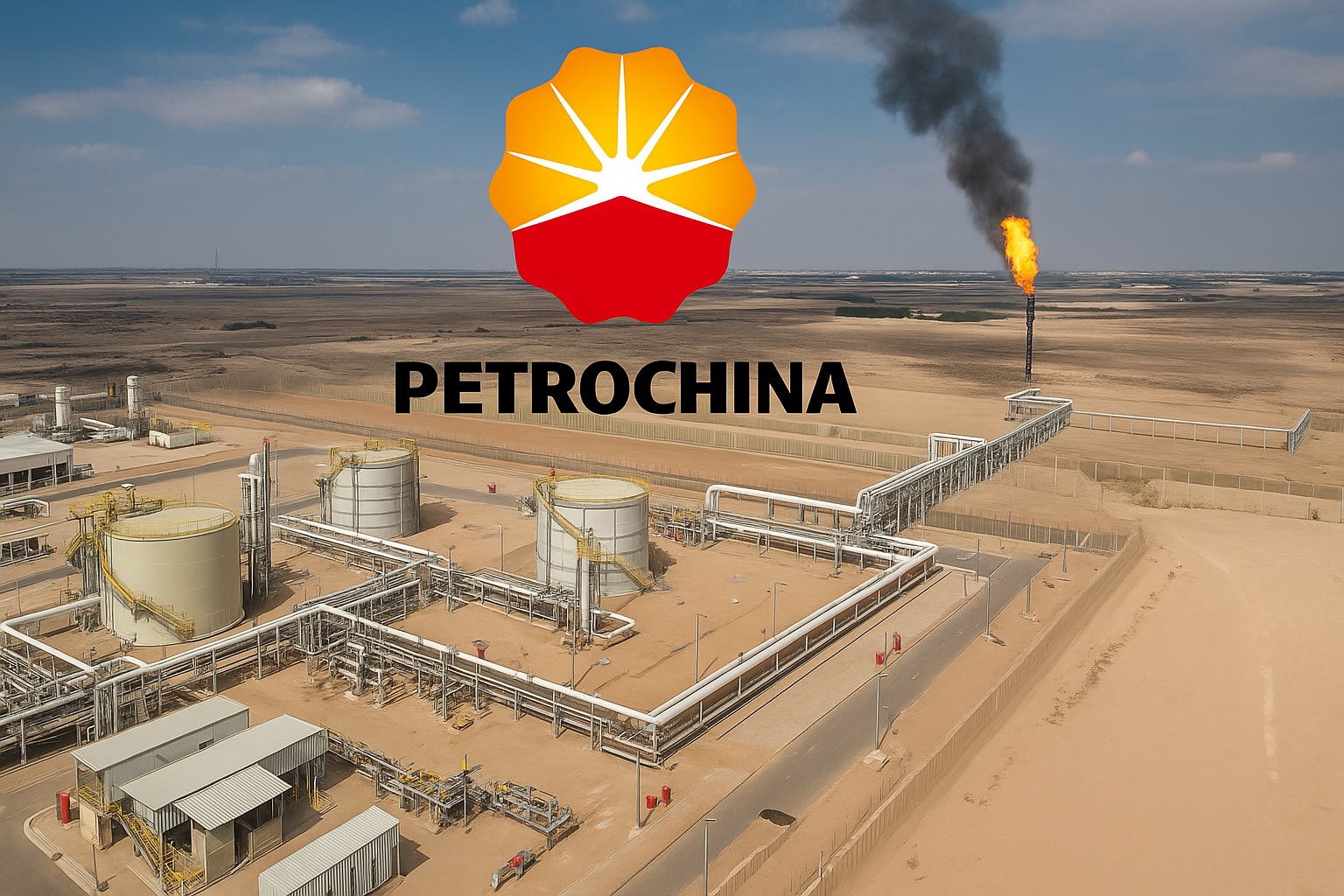- Surging Share Price: PetroChina’s stock (0857.HK) leaped over 4% on October 20 to about HK$7.65, nearing a 52-week high of HK$7.90 [1]. The Hong Kong-listed shares have climbed roughly 50% from spring lows, giving PetroChina a market cap near US$200 billion and a hefty ~7% dividend yield [2].
- Record Profits & Payouts: The state-backed oil & gas giant reported a record net profit of ¥164.7 billion for 2024 (≈US$22.7 billion) [3]. It boosted shareholder returns with a final dividend of ¥0.25 per share (about HK$0.30) [4], contributing to one of the highest yields in its sector.
- Strategic Moves: PetroChina is expanding on multiple fronts. It just added 1.15 billion barrels of new shale oil reserves in northeast China [5] [6] and proposed a ¥40 billion (~$5.6 billion) acquisition of natural gas storage facilities to strengthen its gas supply chain [7] [8].
- Tech & Innovation: In a groundbreaking step, PetroChina’s management revealed plans to pilot stablecoin-based cross-border settlements for oil and gas trades – positioning the firm among the first energy majors exploring regulated digital currency payments [9] [10]. Executives say using Hong Kong–regulated stablecoins could slash forex costs and speed up large international transactions [11] [12].
- Analyst Outlook: Financial experts remain upbeat. Analysts’ consensus on PetroChina is a “Buy,” with an average 12-month target price around HK$8.3 (~14% above current levels) [13] [14]. They cite the company’s resilient cash flows, low valuation (around 7.5× forward earnings), and China’s steady energy demand as supportive factors.
- Energy Market Context: As Asia’s largest oil & gas producer, PetroChina benefits from China’s post-pandemic fuel demand recovery. China’s refinery utilization hit yearly highs in September [15] [16], and the nation’s crude imports averaged 11.5 million barrels/day – underscoring robust domestic consumption. Beijing’s push for energy security and cleaner fuel is driving PetroChina’s investments in natural gas and domestic oil projects.
- Policy & Geopolitics: PetroChina’s state ownership aligns it with Chinese policy goals. The company is growing natural gas output (first-half gas earnings surged even as oil profits dipped [17]) to support China’s transition from coal [18]. At the same time, geopolitical caution is evident: earlier this year PetroChina trimmed Russian oil imports to avoid Western sanctions risks [19], reflecting how international politics shape its trading strategy.
Stock Price on the Rise
PetroChina’s Hong Kong-listed H-shares have been on a notable upswing in recent months. On October 20, the stock jumped to HK$7.65, gaining +4.5% in a single session [20] [21]. Investors bid up the price amid a broader oil sector rally and optimism around the company’s latest moves. At current levels, PetroChina is trading near its highest price of the past year (52-week high: HK$7.90) [22]. The stock has dramatically rebounded from its 52-week low of HK$5.07 in April [23], reflecting improved market sentiment.
Year-to-date, PetroChina’s share price is roughly flat to modestly higher, but that belies significant volatility – a mid-year surge to new highs followed by a late-summer pullback. Even so, long-term shareholders have enjoyed strong returns; PetroChina’s stock has more than tripled over the past five years, according to analysts [24]. With a current market capitalization around US$210 billion, PetroChina ranks among the world’s most valuable energy companies [25]. Its valuation multiples remain relatively low – around 7.5 times forward earnings and ~0.8 times book value [26] – suggesting the stock is still priced cautiously despite recent gains. Income-focused investors are particularly drawn by the rich dividend yield of about 7% [27], which far outstrips broader market averages.
Robust Earnings and Dividend Rewards
PetroChina’s financial performance has underpinned its stock resilience. Full-year 2024 earnings set a new record, as the company reported ¥164.7 billion in net profit [28] – a 2% increase from 2023’s level. This record profit came even as oil prices were slightly lower on average; higher production volumes and operational efficiencies helped offset pricing headwinds [29] [30]. Revenue in 2024 was ¥2.94 trillion, down about 2.5% year-on-year [31], but improved cost control kept the bottom line growing. Notably, PetroChina pumped 941.8 million barrels of crude oil in 2024 (approximately 2.57 million barrels per day), a slight increase of 0.5% from the prior year [32]. Natural gas output jumped 4.1% to 5,134 billion cubic feet [33], highlighting growth in cleaner fuel production.
This earnings strength is translating into generous dividends for shareholders. PetroChina’s board proposed a final dividend of ¥0.25 per share for 2024 [34] – roughly HK$0.29 for H-share investors – on top of an interim payout earlier in the year. The final dividend represents a modest increase and brings the annual payout to around HK$0.51 per share, up from HK$0.47 the previous year [35]. At the current share price, that equates to a yield above 7%, underlining PetroChina’s appeal as a high-yield value stock [36]. “The higher dividend payout ratio is a mild positive,” noted Morningstar analyst Chokwai Lee in an August report, adding that the firm’s ample cash flow easily supports its dividends. PetroChina’s cash from operations topped ¥406 billion in 2024 [37], and capital spending is budgeted slightly lower in 2025 (¥262 billion) [38], indicating disciplined investment and potential for continued shareholder returns.
Expanding Reserves and Shifting to Gas
Beyond headline profits, PetroChina has been actively strengthening its asset base and repositioning for the future. Oil and gas reserves are on the rise. In September, Chinese state media announced PetroChina had proven an additional 1.15 billion barrels of shale oil reserves at its Gulong pilot project in Heilongjiang [39]. This major find at the Daqing Gulong shale play – now producing ~25,500 barrels per day of tight oil – will boost PetroChina’s shale output to an expected 136,000 barrels/day this year, up from 100,000 barrels/day last year [40]. Tapping these harder-to-extract resources is part of PetroChina’s strategy to arrest declines in domestic oil production [41] and reduce China’s reliance on imports.
On the natural gas front, PetroChina is making a strategic push aligned with China’s clean-energy policies. In late August, the company unveiled a ¥40 billion plan to acquire three large natural gas storage facilities from its parent, China National Petroleum Corp (CNPC) [42]. The deal – for storage sites in Xinjiang, Xiangguosi, and Liaohe – would add nearly 11 billion cubic meters of working gas capacity [43]. “This will enhance adjustment efficiency and maximize the overall benefits of the natural gas industry chain,” PetroChina said of the acquisition in an exchange filing [44]. Essentially, the move bolsters China’s gas infrastructure, enabling PetroChina to better handle seasonal demand swings and supply shocks. It comes as China is upping natural gas consumption to cut coal use and improve air quality [45]. In fact, PetroChina’s gas segment was a bright spot in recent results – first-half 2025 gas business earnings hit ¥18.6 billion, higher than the year-ago period [46], even as total net income dipped 5.4% in H1 [47]. Management projects Chinese natural gas demand will “recover and grow rapidly” in coming years [48], and the company is clearly capitalizing on this trend.
Another strategic move is PetroChina’s planned refinery overhaul. The company has been phasing out older refining capacity – including the closure of its 410,000 bpd Dalian refinery by mid-2025 – while investing in more advanced complexes [49]. In June, Reuters reported PetroChina approved a multibillion-dollar new refinery and petrochemical complex in northeastern China [50]. Modern facilities will allow PetroChina to produce higher-value fuels and petrochemicals more efficiently, keeping its downstream segment competitive even as domestic fuel demand plateaus. Indeed, in 2024 the company’s chemical products output surged by 49%, helping offset declines in gasoline and diesel sales [51] [52]. These moves underscore PetroChina’s adaptation in a changing energy landscape – balancing oil, gas, and petrochemicals to maintain growth.
Embracing Fintech: Stablecoin Settlement Pilot
In a sign of the times, PetroChina is also venturing into blockchain-based finance – a novel development for a state-owned energy titan. At its latest earnings briefing, PetroChina’s CFO Wang Hua revealed the company is studying the use of stablecoins for cross-border settlements in its international trade [53] [54]. This pilot initiative leverages Hong Kong’s new regulatory regime for stablecoins (in effect since August 1) which provides a legal framework for licensed, HKD or USD-pegged digital currencies [55] [56]. PetroChina aims to be one of the first major energy companies to test digital asset payments under regulated conditions.
Why experiment with stablecoins? For PetroChina, which sells and buys petroleum products globally, using a Hong Kong–regulated USD-pegged stablecoin (such as HKDG) could streamline payments and reduce costs. Transactions that currently involve multiple banks and forex conversions might settle almost instantly on a blockchain, eliminating currency exchange fees and delays. Industry analysts note that stablecoins can offer “faster settlement, lower fees, and insulation from FX volatility” in global commerce [57]. PetroChina is “closely monitoring” the Hong Kong Monetary Authority’s guidance as it explores this program, Wang Hua said [58]. If implemented, a portion of PetroChina’s massive trade flows – from crude imports to equipment purchases – could be conducted via digital tokens rather than through the traditional dollar banking system [59] [60].
The symbolic significance of this should not be overlooked. PetroChina is a $200 billion state-owned behemoth – so its foray into crypto-based finance signals a shift in attitude. It reflects China’s nuanced approach: while mainland regulators ban most cryptocurrency trading, Beijing appears willing to use Hong Kong as a sandbox for select state enterprises to trial blockchain innovation under strict oversight [61]. A Chinese oil giant experimenting with stablecoins suggests that fintech is entering the mainstream of commodity trade. Should the pilot succeed, it may pave the way for broader adoption of digital currency in oil trading and even put pressure on global banks to integrate blockchain networks for their corporate clients. PetroChina’s bold step thus positions it at the forefront of marrying traditional energy business with fintech modernization.
Market Outlook and Analyst Views
Looking ahead, PetroChina’s outlook appears solid, supported by stable fundamentals and favorable market dynamics in Asia. China’s oil demand remains robust – evidenced by record refinery runs in September and crude import volumes holding above 11 million bpd [62] [63]. Although Chinese refiners face periods of oversupply (with fuel output occasionally outpacing domestic demand) [64], the country’s ongoing economic recovery and expanding travel sector (jet fuel demand +9% in 2024 [65]) should absorb additional volumes. Meanwhile, the government’s emphasis on energy security bodes well for PetroChina: Beijing has accelerated building strategic oil reserves [66] and is encouraging state firms to boost domestic production, which aligns with PetroChina’s reserve additions and upstream investments.
Financial analysts largely agree that PetroChina is in a strong position. The consensus rating on the stock is “Buy,” according to a poll of 16 analysts [67]. This consensus reflects confidence in PetroChina’s earnings stability and dividend policy even amid oil price swings. The average 12-month price target is HK$8.34 [68], implying roughly 14% upside from current levels [69]. Some bullish analysts see even more potential if oil prices stay elevated – high estimates run up to HK$10, which would be new all-time highs. J.P. Morgan, Goldman Sachs, and other firms reiterated Buy ratings in recent months with targets around HK$8–$9 [70] [71]. PetroChina’s low valuation, high yield, and improving return on equity (9.3% ROE last year [72]) make it attractive in comparison to global peers. “PetroChina should benefit from higher long-term oil prices,” Morningstar noted in August, especially given its leverage to China’s growth and a more profitable gas business.
Risks remain, of course. A sharp drop in oil prices or a global recession would weigh on PetroChina’s earnings. The company is also contending with rising competition in China’s fuel market – management cautioned that “domestic refined oil market competition will further intensify” in 2025 [73] as independent refiners (the “teapots”) and Sinopec battle for market share. Nonetheless, PetroChina’s integrated model (from upstream exploration to retail fuel stations) and state backing give it resilience. Fitch Ratings affirmed PetroChina’s ‘A’ credit rating with Stable outlook in July, citing the firm’s robust cash flows and the “very high likelihood” of government support if needed. This means PetroChina can comfortably fund its hefty capital expenditures (¥260+ billion/year) without jeopardizing dividends or balance sheet health.
Overall, investors and experts see PetroChina as a relatively low-risk play on China’s energy market. The combination of steady profits, proactive strategy shifts, and a shareholder-friendly dividend policy suggests the stock could continue to perform well. With China’s economy gradually rebounding and oil prices hovering at profitable levels, PetroChina is positioned to sustain its momentum. The exploratory steps into digital currency settlements also hint at a forward-looking mindset that could unlock efficiencies down the road. Barring any major shocks, the consensus is that PetroChina will remain a cornerstone of Asia’s oil & gas industry – and a potentially rewarding holding for those banking on China’s long-term growth and energy needs.
Broader Energy and Policy Context
PetroChina’s fortunes are closely tied to the broader energy landscape in Asia, where it plays a dominant role. China is not only the world’s largest crude importer but also a growing force in natural gas and petrochemical markets. The government’s policies heavily influence PetroChina’s operating environment. In recent years, Beijing has pursued a balancing act: ensure energy security (through domestic output and strategic reserves) while also transitioning to cleaner fuels (hence the emphasis on gas, renewables, and electric vehicles). PetroChina, as the listed arm of CNPC, is at the forefront of implementing these policies. The company has markedly increased domestic drilling – both conventional and unconventional – supported by tax incentives and research subsidies. Its discovery of huge shale oil reserves and ongoing oilfield developments (e.g. in Xinjiang and offshore) dovetail with China’s push to reduce import dependence. At the same time, PetroChina is channeling more capital to natural gas projects, from new gas fields to LNG import terminals, aligning with China’s pledge to peak carbon emissions before 2030.
Geopolitical factors also ripple through PetroChina’s business. The past year illustrated this: after Russia’s war in Ukraine, Chinese state refiners like PetroChina became major buyers of discounted Russian crude. However, new Western sanctions in early 2025 prompted caution. In March, PetroChina and CNOOC quietly scaled back on spot purchases of Russia’s ESPO crude to ensure compliance with U.S. sanctions limits [74]. PetroChina still continued lifting around 800,000–900,000 barrels per day of Russian oil via long-term pipeline deals, but trimmed seaborne imports for a time [75]. This highlights how PetroChina must navigate international sanctions and diplomacy, given its global supply chains. Likewise, trade tensions or tariffs (for example, U.S.–China disputes) could affect fuel exports or equipment imports. On the flip side, PetroChina stands to gain from warmer China-Middle East ties – for instance, securing upstream stakes or long-term oil contracts in Gulf states can lock in supply. The company’s recent interest in North American LNG volumes (to diversify sourcing) also reflects a pragmatic approach to geopolitical risk [76].
In summary, PetroChina’s stock is riding high on a confluence of positive factors: strong financial results, proactive strategic initiatives, supportive market conditions, and innovations like the stablecoin pilot. As one of China’s most important companies, PetroChina is effectively executing its mandate to fuel the nation’s growth while adapting to new energy realities. For investors, PetroChina offers a unique combination of value and yield, underpinned by tacit state support. The coming months will show whether it can build on recent momentum – early indicators, from analyst optimism to policy tailwinds, suggest that China’s oil dragon still has room to run in this evolving energy era.
Sources: PetroChina company filings and Reuters reports [77] [78] [79] [80]; industry analysis by TS2 Techstock² and Investing.com [81] [82] [83]; Reuters news on China’s energy markets [84] [85] and geopolitical developments [86].
References
1. www.reuters.com, 2. www.reuters.com, 3. www.reuters.com, 4. www.reuters.com, 5. www.reuters.com, 6. www.reuters.com, 7. www.reuters.com, 8. www.reuters.com, 9. ts2.tech, 10. ts2.tech, 11. ts2.tech, 12. ts2.tech, 13. www.investing.com, 14. www.investing.com, 15. www.reuters.com, 16. www.reuters.com, 17. www.reuters.com, 18. www.reuters.com, 19. www.reuters.com, 20. www.reuters.com, 21. www.reuters.com, 22. www.reuters.com, 23. www.reuters.com, 24. finance.yahoo.com, 25. hk.marketscreener.com, 26. www.reuters.com, 27. www.reuters.com, 28. www.reuters.com, 29. www.reuters.com, 30. www.reuters.com, 31. www.reuters.com, 32. www.reuters.com, 33. www.reuters.com, 34. www.reuters.com, 35. links.sgx.com, 36. www.reuters.com, 37. www.reuters.com, 38. www.reuters.com, 39. www.reuters.com, 40. www.reuters.com, 41. www.reuters.com, 42. www.reuters.com, 43. www.reuters.com, 44. www.reuters.com, 45. www.reuters.com, 46. www.reuters.com, 47. www.reuters.com, 48. www.reuters.com, 49. www.reuters.com, 50. www.reuters.com, 51. www.reuters.com, 52. www.reuters.com, 53. ts2.tech, 54. ts2.tech, 55. ts2.tech, 56. ts2.tech, 57. ts2.tech, 58. ts2.tech, 59. ts2.tech, 60. ts2.tech, 61. ts2.tech, 62. www.reuters.com, 63. www.reuters.com, 64. www.reuters.com, 65. www.reuters.com, 66. www.reuters.com, 67. www.investing.com, 68. www.investing.com, 69. www.investing.com, 70. www.investing.com, 71. www.investing.com, 72. www.reuters.com, 73. www.reuters.com, 74. www.reuters.com, 75. www.reuters.com, 76. www.reuters.com, 77. www.reuters.com, 78. www.reuters.com, 79. www.reuters.com, 80. www.reuters.com, 81. ts2.tech, 82. www.investing.com, 83. www.investing.com, 84. www.reuters.com, 85. www.reuters.com, 86. www.reuters.com










